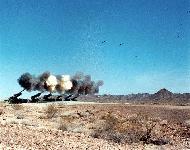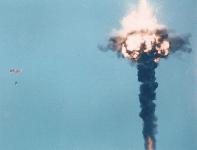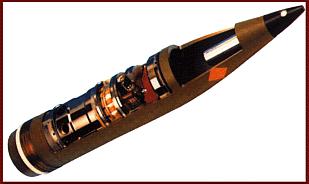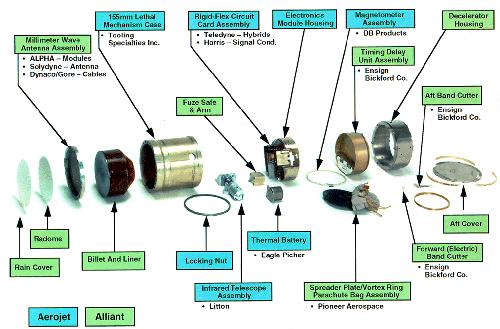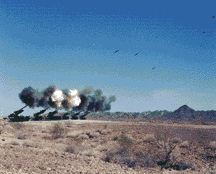
 SADARM (Sense and Destroy Armor) is a "smart" artillery submunition designed for precision engagement of
self-propelled howitzers as well as other lightly armored vehicles. By destroying the
enemy's self-propelled counterfire capability, SADARM contributes to
full-dimensional protection. Denying the enemy's use of self-propelled howitzers
better enables friendly forces to move at will and dominate maneuver.
The is the basic developmental projectile, and the XM982 - Similiar to the M483A1 with the addition of a rocket motor to further increase the effective
range, and with options to increase delivery accuracy.
SADARM is designed to attack and kill lightly armored vehicles. SADARM is
dispensed from a 155 millimeter (mm) howitzer round. Each howitzer round delivers
two submunitions. Once dispensed, the submunition deploys a parachute-like
deceleration device. At a predetermined distance from the ground, the submunition
ejects the deceleration device and deploys another device to stabilize and rotate the
submunition. As the submunition falls and rotates, it searches the ground with a
millimeter wave sensor and an infrared sensor array. Using the two sensors and
detection logic, the submunition is designed to detect countermeasured targets in a
variety of climates. If the sensor detects a target, the submunition fires an
explosively formed penetrator (EFP) at the target. If no target is detected the
submunition is designed to self-destruct.
SADARM (Sense and Destroy Armor) is a "smart" artillery submunition designed for precision engagement of
self-propelled howitzers as well as other lightly armored vehicles. By destroying the
enemy's self-propelled counterfire capability, SADARM contributes to
full-dimensional protection. Denying the enemy's use of self-propelled howitzers
better enables friendly forces to move at will and dominate maneuver.
The is the basic developmental projectile, and the XM982 - Similiar to the M483A1 with the addition of a rocket motor to further increase the effective
range, and with options to increase delivery accuracy.
SADARM is designed to attack and kill lightly armored vehicles. SADARM is
dispensed from a 155 millimeter (mm) howitzer round. Each howitzer round delivers
two submunitions. Once dispensed, the submunition deploys a parachute-like
deceleration device. At a predetermined distance from the ground, the submunition
ejects the deceleration device and deploys another device to stabilize and rotate the
submunition. As the submunition falls and rotates, it searches the ground with a
millimeter wave sensor and an infrared sensor array. Using the two sensors and
detection logic, the submunition is designed to detect countermeasured targets in a
variety of climates. If the sensor detects a target, the submunition fires an
explosively formed penetrator (EFP) at the target. If no target is detected the
submunition is designed to self-destruct.

1. Delivery
2. Dispense
3. Decelerate-MMW Alt Measurement
4. Deploy Parachute
5. Activate Sensor Processing
6. Initiate Search & Enable Fire
7. Detection Scan
8. Confirmation Scan-Fire EFP
The Army is pursuing a SADARM product improvement (PI) as part of a cost reduction program. The PI will increase SADARM's effectiveness by increasing the detection area and potentially using a new EFP design. Several EFP designs are being considered. The new EFP should increase effectiveness against self-propelled howitzers as well as other targets. The PI will be cut into the current production line. According to the current strategy, the SADARM PI will make up at least 90 percent of the total SADARM buy. SADARM is currently in low-rate production. After technical tests in June and July 1993, SADARM testing was suspended due to poor performance. The Army conducted an extensive failure analysis and program review. In April 1994, 13 projectiles (26 submunitions) scored 11 hits at a range of approximately 15 kilometers. However, there were still problems at the longest ranges as well as submunition mid-air collision problems. The Army restructured the program to allow a limited low rate production. The low-rate production supported additional tests of the system. Countermeasure and non-desert tests were also added to the program, and the operational test was expanded as a final confirmation prior to entering full-rate production. Based on the test results and the restructured program, the defense acquisition board (DAB) allowed the program to enter low rate production in March 1995. The DAB delegated the full rate production decision to the Army contingent on achieving an exit criterion. Early in 1996, the Army began the first tests of the low-rate production articles. In March and April 1996, the Army conducted tests at Yuma Proving Ground to confirm fixes for the collision problems. There were 8 hits with 9 rounds (18 submunitions) fired at 18 km, close to the longest range. This exceeded the exit criterion for the test and no collisions were observed.
